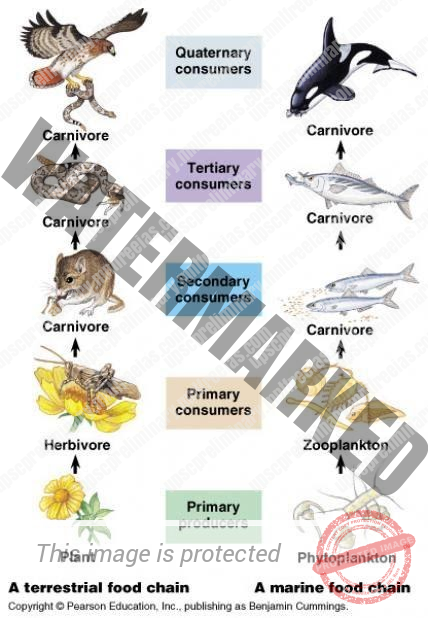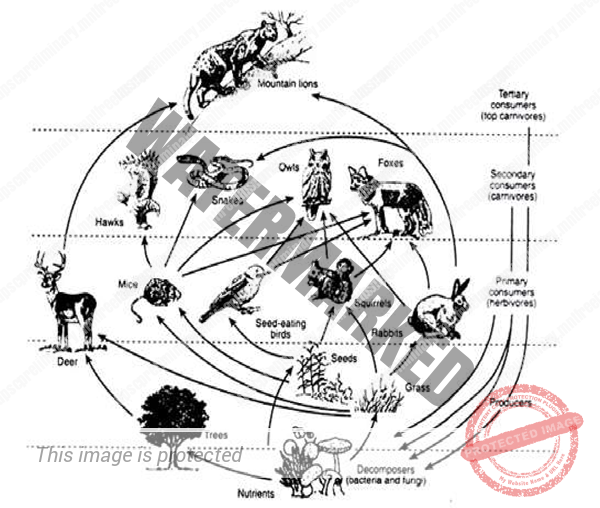- FUNCTIONS OF AN ECOSYSTEM
- PRODUCTIVITY
- FOOD CHAINS
- FOOD WEBS
- SIGNIFICANCE OF FOOD CHAINS AND FOOD WEBS
UNIT 1 – ECOLOGY & ECOSYSTEM – PART 4
FUCNTIONS OF AN ECOSYSTEM
PRODUCTIVITY
The rate of biomass production is called productivity. The portion of fixed energy, a trophic level passes on to the next trophic level is called production. Productivity in ecosystems is of two kinds, i.e., primary, and secondary.
Green plants fix solar energy and accumulate it in organic forms as chemical energy. As this is the first and basic form of energy storage, the rate at which the energy accumulates in the green plants or producers is known as primary productivity.
Productivity is a rate function and is expressed in terms of dry matter produced or energy captured per unit area of land, per unit time. It is more often expressed as energy in calories/cm2/yr or dry organic matter in g/m2/yr (g/m2 x 8.92 = lb/acre). Hence, the productivity of different ecosystems can be easily compared.
Primary productivity has two aspects:
(i) Gross and
(ii) Net.
The total solar energy trapped in the food material by photosynthesis is referred to as Gross Primary Productivity (GPP).
The amount of energy-bound organic matter created per unit area and time that is left after respiration is Net Primary Productivity (NPP).
Net productivity of energy = Gross productivity — Energy lost in respiration.
FOOD CHAINS
The transfer of food energy through a sequence of eating and being eaten by the organisms in an ecosystem is termed as the food chain.
For example,
In a grassland ecosystem, grass fixes the light energy from the sun into chemical energy via synthesis of food and eaten up by a grasshopper, which in turn is eaten by a frog and the frog itself is eaten up by a snake.
So, grass is food for grasshopper, grasshopper is food for frog and the frog is food for snake. Thus, grass, grasshopper, frog and snake make a food chain, through which energy contained in food is transferred from one organism to another.
Examples of food chains in different ecosystems:
GRASSLAND ECOSYSTEM
- Grass → Grasshopper → Frog → Snake → Eagle
FOREST ECOSYSTEM
(2) Tree → Fruit eating Birds → Eagle
(3) Plant → Deer → Lion
POND ECOSYSTEM
(4) Phytoplankton → Zooplankton → Small fish → Big fish → Human beings
The position of organisms along a food chain is referred to as TROPHIC LEVEL.
All the green plants (primary producers) belong to FIRST TROPHIC LEVEL.
Plant eaters or herbivores (primary consumers) belong to SECOND TROPHIC LEVEL, Carnivores or Secondary consumers to the THIRD TROPHIC LEVEL, and other Carnivores or Tertiary consumers to FOURTH TROPHIC LEVEL and so on.
The top carnivores in the food chain are known as the top predator. However, a species can occupy more than one Trophic Level. As in the above given examples of food chain in grassland ecosystem, an eagle acts as a top predator and occupy Fifth Trophic Level.
Trophic level
TYPE OF ORGANISM |
ENERGY SOURCE |
EXAMPLE |
PRIMARY PRODUCER |
SUN |
Trees, plants, algae, phytoplankton’s |
PRIMARY CONSUMER |
PRIMARY PRODUCER |
Herbivores (Grasshopper, deer, giraffe, zooplanktons) |
SECONDARY CONSUMER |
PRIMARY CONSUMER |
Carnivores (Frogs, lizards, crabs, wolf, small fish) |
TERTIARY CONSUMER |
SECONDARY CONSUMER |
Top Carnivores (Eagle, tiger, lion, sea otters, big fishes) |
ENERGY TRANSFER EFFICIENCY LIMITS FOOD CHAIN LENGTHS
Energy is transferred between trophic levels in the form of food energy when one organism eats another in the ecosystem. There is approximately 80- 90% loss of energy at each transfer. When energy enters a trophic level, some of it is stored as biomass, as part of organism’s body. This is the energy available to the next trophic level since only energy stored as biomass can get eaten.
As a rule of thumb, only about 10% of the energy stored as biomass in one trophic level per unit time ends up stored as biomass in the next trophic level per the same unit time. This is 10% rule of energy transfer in the ecosystem. Therefore, the shorter the food chain – or nearer the organism to the Producer Trophic Level – greater will be the energy available at that population.
GRAZING FOOD CHAIN
The grazing food chain is the major food chain dominantly occurring in ecosystems. As obvious from the name, it starts from the Green Plants, the major source of energy for this chain is taken from the sun as plants carry out the process of photosynthesis in presence of sunlight. The green plants are the primary producer and eaten up by herbivores, which in turn are eaten up by carnivores. This food chain doesn’t consist of microbes or other decomposers; it is carried out by the macroscopic organisms.
FOOD WEBS
A food web can be defined as a network of food chains interconnected to each other so that a number of options of eating and being eaten are available at each Trophic Level.
It was Charles Elton who presented the notion of food web what he referred to as food cycle (Krebs 2009). In 1927, he recognized that the length of these food chains was mostly limited to 4 or 5 links and the food chains were not isolated, but hooked together into food webs
It offers an important tool for investigating the ecological interactions that define energy flows and predator-prey relationship.
FACTORS INFLUENCING FOOD CHAIN:
The complexity of food webs depends upon the diversity of organisms in the ecosystem. It would depend on two factors:
- Length Of Food Chain: Diversity in the organisms based upon their food habits would determine the length of food chain. More diverse the organisms in food habits, longer would be food chain.
- b) Alternatives At Different Trophic Levels in The Food Chain: More the alternatives, more would be the interlocking pattern. In deep oceans, sea etc. the food webs are very complex due to the presence of wide variety of organisms.
SIGNIFICANCE OF FOOD CHAINS AND FOOD WEBS:
- The Food Chains and Food Webs help understand the feeding relationships and the interactions between organisms in any ecosystem.
- Nutrient cycling and energy flow in an ecosystem takes place through food chains and food webs.
- Food chains keep a check on the population size of different organisms. For example, in a food chain in grassland, if deer population increases, there will be more food for the carnivores, their population will increase, which in turn will reduce the deer population. If there are less deer, some of the carnivores will starve and die, letting the deer population to grow.
- Food webs are very important in maintaining the stability of an ecosystem in nature. In a linear food chain, if one species become extinct or one species suffers then the species in the subsequent trophic levels are also affected. In a food web, on the other hand, there are a number of options available at each trophic level. So, if one species is affected, it does not affect other trophic levels so seriously.
- The study of food chain helps us to understand the problems of bio magnifications. Sometimes certain toxic substances, instead of dispersing, get concentrated at each level in the food chain and are referred to as biological magnification or bioaccumulation.


